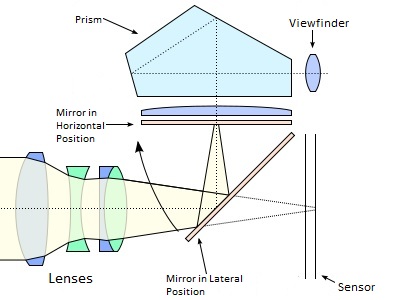| Line 1: | Line 1: | ||
| − | [[Category: | + | [[Category:ECE637]] |
= Intro to Optical Imaging Systems = | = Intro to Optical Imaging Systems = | ||
Revision as of 07:57, 9 April 2013
Contents
Intro to Optical Imaging Systems
All Notes > Topic 1: Optical Imaging Systems > Intro
sLecture
SLR and DSLR Cameras
This portion of the lecture provides an overview of digital imaging systems, digital cameras and lenses. Images are typically captured via optical imaging systems, particularly cameras. The figure below describes the mechanism behind how an image is captured in a Single Length Reflex (SLR) camera.
As you point your camera at an object and look through the viewfinder, light from the object passes through the lens and is incident on the mirror, which is positioned laterally so as to reflect the light through the prism and into the viewfinder. Once you click to take a picture, the aperture closes and the mirror moves to the horizontal position shown in the figure. Next, the aperture reopens for the amount of time specified by the mode you have your camera set to. This time the light passing through the lens is incident upon the light sensor. In a DSLR camera, the information from the sensor is digitized and stored in local memory. Once this is completed, the mirror moves back to the lateral position and you can view objects through the viewfinder again.
The key item in the design of a camera is the lens and it is important to characterize the imaging system. You can find the notes on these two topics in the links provided below.
References
- Bouman, Charles. Digital Image Processing I. Purdue University. Spring 2013. Lecture.
Questions and comments
If you have any questions, comments, etc. please post them below:
- Comment / question 1


